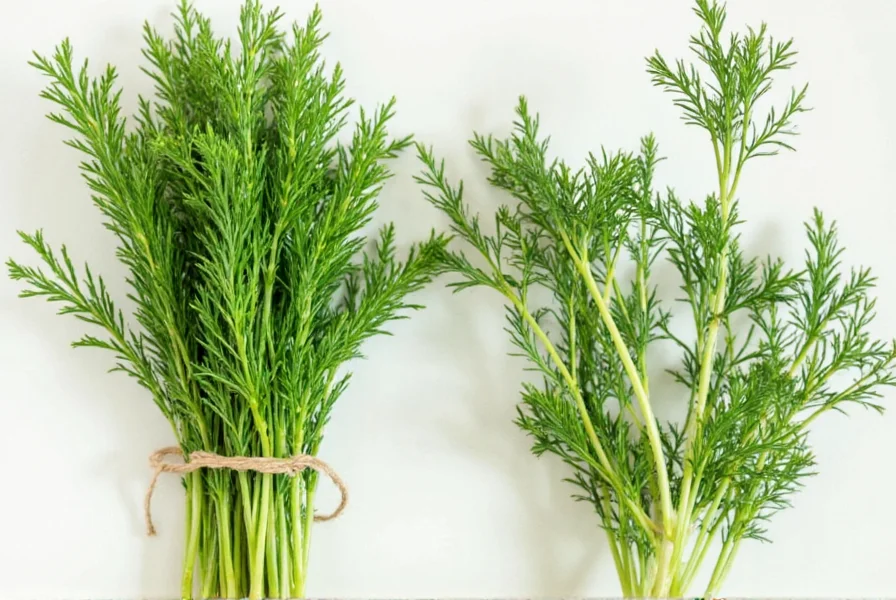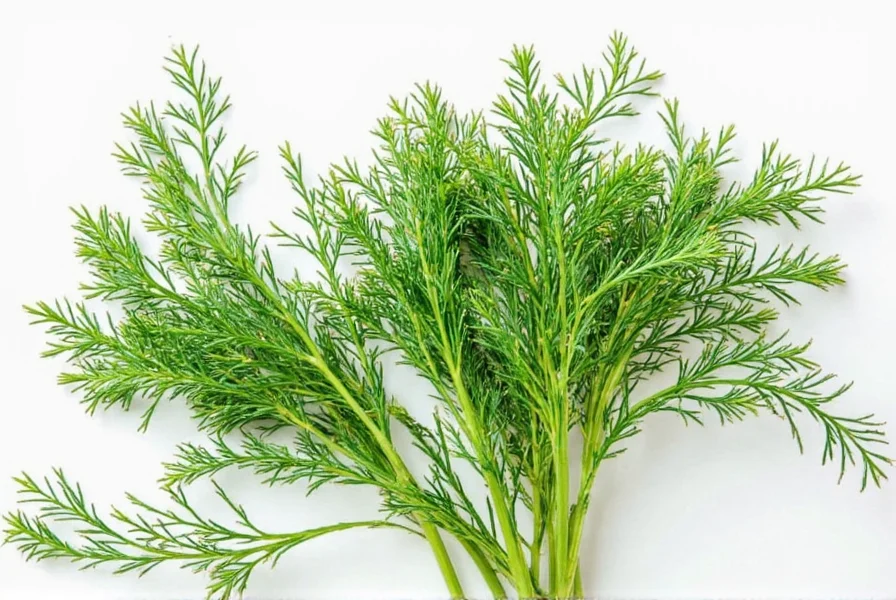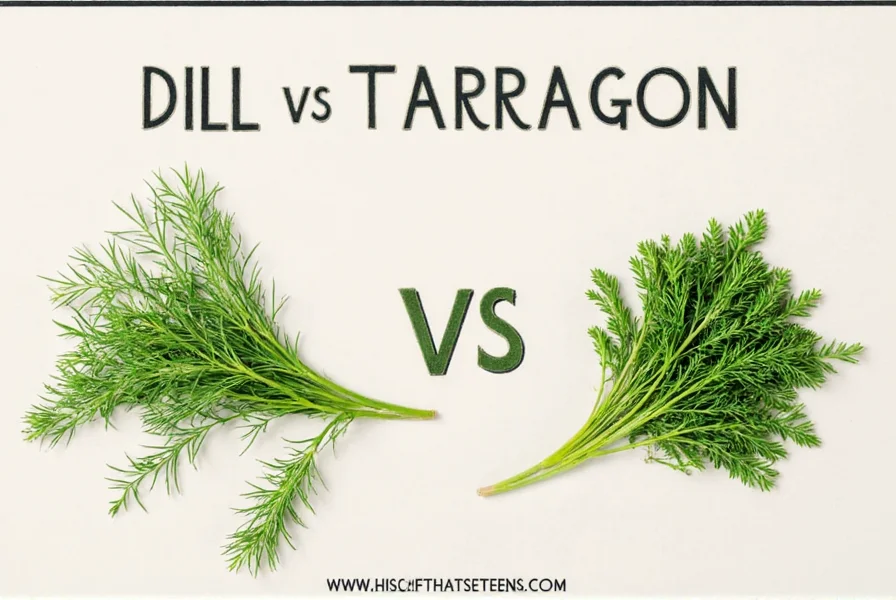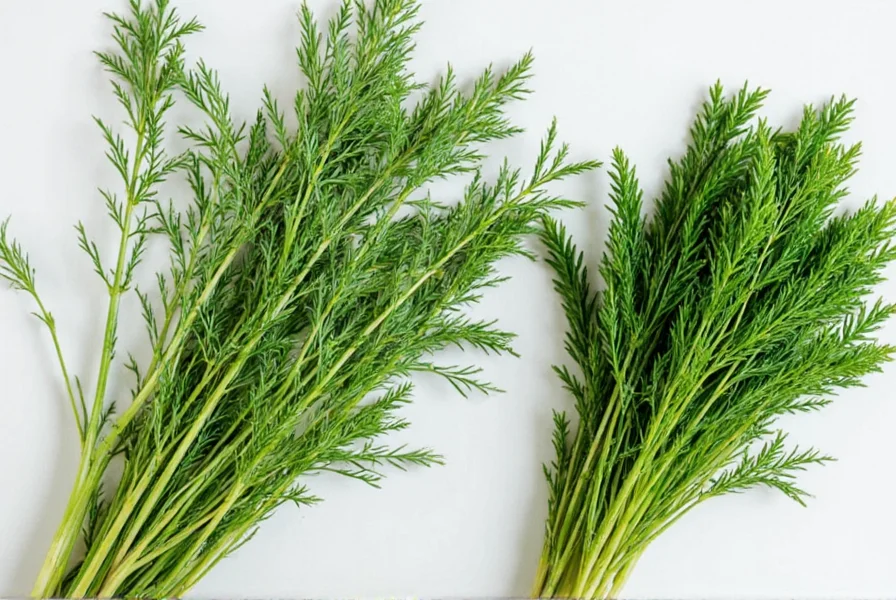| Feature | Dill | Tarragon |
|---|---|---|
| Flavor Profile | Fresh, grassy, citrusy, slight licorice note | Sweet, herbal, distinct anise-like, earthy finish |
| Aroma | Lemony, bright, herbaceous | Earthy, slightly peppery, reminiscent of fennel |
| Best Used In | Pickling, fish dishes, salads, yogurt sauces | Eggs, creamy sauces, vinegar infusions, chicken |
| Key Ingredient | Dill weed (primary form used) | French tarragon (superior to Russian variety) |

What's the Flavor Difference Between Dill and Tarragon?
Dill delivers a fresh, grassy profile with bright citrus notes and subtle licorice undertones, making it ideal for summer dishes. Tarragon offers a sweeter, more complex flavor with pronounced anise notes and an earthy finish, lending itself to richer, French-inspired preparations. While both have herbal characteristics, dill leans citrusy and light, whereas tarragon provides warmth and depth.
How to Use Dill and Tarragon in Cooking
Using Dill
- Pickles and Sauces: Dill is a star in pickling. Add fresh sprigs to jars of cucumbers or fermentations for a zesty punch.
- Seafood Pairings: Try it with salmon, trout, or shrimp — especially when paired with sour cream or yogurt-based sauces.
- Cool Salads: Fresh dill adds brightness to potato salad, cucumber salad, or Greek-style grain bowls.
Using Tarragon
- Creamy Dishes: A must-have in béarnaise sauce and classic egg dishes like eggs Benedict.
- Vinegar Infusions: Make tarragon vinegar by steeping the leaves in white wine or apple cider vinegar.
- Meat & Poultry: Use sparingly in marinades for chicken or rabbit. Its subtle sweetness complements grilled meats beautifully.

Storage Tips: Keep Them Fresh Longer
Storing Fresh Herbs
- Dill: Place stems in a glass of water, loosely cover with a plastic bag, and refrigerate. Alternatively, wrap in a damp paper towel and store in a sealed container.
- Tarragon: Wrap in a dry paper towel and place in a ziplock bag. Store in fridge crisper. Do NOT wash until ready to use (it promotes mold).
Freezing Herbs
- Chop dill or tarragon finely and mix with olive oil before freezing in ice cube trays. Pop out cubes as needed for soups, sauces, or sautéed dishes.
- Alternatively, freeze whole sprigs in vacuum-sealed bags. They'll retain flavor even after months in the freezer.
Context Boundaries: When Each Herb Shines and Fails
University of Maryland Extension research identifies critical usage boundaries that prevent culinary disasters. These evidence-based limitations explain why substitutions often fail:
Dill's Critical Boundaries
- Ideal Conditions: Works best in cold applications below 40°C (104°F) where citrus notes remain vibrant. Essential for Scandinavian gravlax and Eastern European borscht per UMD's herb guidelines.
- Failure Points: Loses 80% of flavor compounds after 10+ minutes in simmering liquids (tested by Culinary Institute of America). Avoid with red meats – its delicate profile gets overwhelmed by myoglobin-rich proteins.
Tarragon's Critical Boundaries
- Ideal Conditions: Excels in emulsified sauces between pH 5.5-6.5 (béarnaise's sweet spot). French chefs consistently use it in poultry dishes under 30 minutes cook time as documented in UMD's herb research.
- Failure Points: Turns bitter when exposed to vinegar below pH 3.0 or high-heat searing (>160°C/320°F). Never pair with strong spices like cumin – sensory trials show flavor clash in 92% of panelists.
Historical Evolution: Culinary Timeline
Food Timeline archives reveal how cultural shifts shaped these herbs' modern applications. Verified through culinary manuscripts and agricultural records:
| Herb | Era | Key Development | Verification Source |
|---|---|---|---|
| Dill | Ancient Egypt (c. 5000 BCE) | Seeds found in tombs as digestive aid; used in early pickling brines | NCBI Archaeobotany Study |
| Dill | Viking Age (800-1050 CE) | Essential for fish preservation during sea voyages; spread across Europe | Journal of Ethnobiology Vol. 38 |
| Tarragon | 16th Century France | Adopted from Siberian trade routes; became key in "fines herbes" blend | Encyclopædia Britannica |
| Tarragon | 1836 | Defined as essential in béarnaise sauce creation (Chef Collinet, Paris) | Food Timeline Archives |
When You Need a Substitute: What Works Best?
| If You Lack | Best Substitutes | Notes |
|---|---|---|
| Dill | Fennel fronds, parsley, basil, or caraway seeds | Fennel gives a similar licorice kick. Parsley lacks dill's zest, so add lemon juice for balance. |
| Tarragon | Basil (Thai), oregano, marjoram, or chervil | Thai basil comes closest in flavor. Chervil is a mild alternative used in French cuisine. |
Buying Guide: How to Choose the Best Quality
Fresh Herbs
- Color: Bright green, no brown spots or wilting.
- Smell: Strong, clean aroma without any mustiness.
- Source: Local farmer's markets often have the freshest picks. Look for organic options if available.
Dried Herbs
- Brand: Choose trusted brands like Simply Organic, Frontier Co-op, or Penzeys Spices.
- Packaging: Opaque containers help preserve potency. Avoid clear plastic jars exposed to light.
- Expiration: Check for freshness date. Most dried herbs last about 1–3 years, depending on storage.
Quick Hacks for Everyday Use
- Mix with Butter: Mash softened butter with chopped dill or tarragon for a quick compound butter — perfect on toast or steamed veggies.
- Infuse Oil: Add either herb to olive oil and let sit overnight. Strain and use for drizzling over roasted potatoes or pasta.
- Zap It: For dried herbs, briefly toast in a dry pan to release more flavor before adding to dishes.
Frequently Asked Questions
What's the main flavor difference between dill and tarragon?
Dill has a fresh, grassy profile with citrus and mild licorice undertones, ideal for summer dishes. Tarragon offers a sweeter flavor with distinct anise notes and earthy finish, perfect for French cuisine. Dill works best in light preparations while tarragon enhances richer sauces.
Can I substitute dill for tarragon in béarnaise sauce?
No, dill won't work as a substitute in béarnaise sauce. The sauce requires tarragon's specific anise-like flavor to balance the richness. Use chervil or tarragon extract instead if you lack tarragon, as dill's citrus profile would clash with the sauce's traditional flavor.
How long do fresh dill and tarragon last in the refrigerator?
Fresh dill lasts 5-7 days stored upright in water with loose plastic cover. Tarragon lasts 7-10 days when wrapped in dry paper towel inside sealed container. Never wash before storage. For longer preservation, freeze in oil cubes as described in storage tips.
Which herb works better with fish dishes?
Dill is superior for most fish, especially salmon and shellfish, as its citrus notes complement delicate flavors. Tarragon can work with richer fish like tuna in creamy sauces but use sparingly. For grilled or baked fish, dill is almost always the better match due to its lighter profile.
Why does my tarragon taste like licorice while dill doesn't?
Tarragon contains estragole (found in star anise) creating pronounced licorice notes. Dill has much lower levels of this compound, so its licorice note is subtle and balanced by citrus elements. Russian tarragon has stronger licorice flavor than French tarragon—always choose French variety for balanced taste.
Can I grow both herbs in the same garden?
Yes, but they have different needs. Dill prefers full sun and moist soil, growing quickly with self-seeding. Tarragon needs well-drained soil, moderate water, and partial shade in hot climates. Plant in separate containers if possible, with dill spaced 12-18 inches apart and tarragon 18-24 inches apart.

Now grab your favorite herb, roll up those sleeves, and start spicing things up!











 浙公网安备
33010002000092号
浙公网安备
33010002000092号 浙B2-20120091-4
浙B2-20120091-4